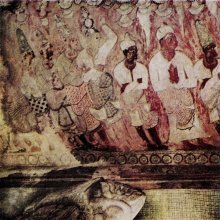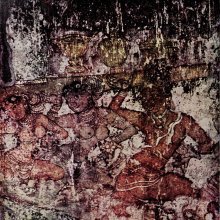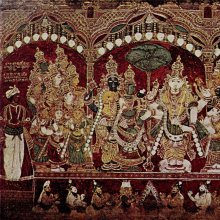Rajaraja, Rajan-raja, Rājarāja: 16 definitions
Introduction:
Rajaraja means something in Hinduism, Sanskrit, the history of ancient India, Marathi. If you want to know the exact meaning, history, etymology or English translation of this term then check out the descriptions on this page. Add your comment or reference to a book if you want to contribute to this summary article.
Images (photo gallery)
In Hinduism
Purana and Itihasa (epic history)
Source: archive.org: Shiva Purana - English TranslationRājarāja (राजराज) or Rājarājan is a name that Guṇanidhi obtained from Umā, as a result of his severe penance, as mentioned in the Śivapurāṇa 2.1.19. Accordingly, as Umā said to Guṇanidhi:—“[...] dear son, I am delighted at your penance. I shall give you the boon you desire. You will be the lord of treasures and the lord of Guhyakas. You will be the king of Yakṣas, Kinnaras and rulers [viz., Rājarāja]. You will be the leader of Puṇyajanas and the bestower of wealth to all. My friendship with you shall remain for ever. I shall stay near you, very near Alakā, dear friend, in order to increase your love. O son of Yajñadatta, great devotee, come on. This is your mother. Fall at her feet with delighted heart”.
Source: Cologne Digital Sanskrit Dictionaries: The Purana IndexRājarāja (राजराज).—The giver of gift; kalpa tree becomes so in the next birth;1 for the gift of gosahasra.2

The Purana (पुराण, purāṇas) refers to Sanskrit literature preserving ancient India’s vast cultural history, including historical legends, religious ceremonies, various arts and sciences. The eighteen mahapuranas total over 400,000 shlokas (metrical couplets) and date to at least several centuries BCE.
India history and geography
Source: academia.edu: The Yona or Yavana Kings of the time of the Legendary King AshokaKing Rajaraja.—Jayaratha wrote a commentary on Tantraloka. According to him, his father Shringararatha was the minister of Kashmir King Rajaraja.
Source: What is India: Epigraphia Indica volume XXXI (1955-56)Rājarāja is the name of a king who belonged to the Pratihāra dynasty. An inscription from Chanderi in the Guna District (in the former Gwalior State) of Madhya Bhārat (11th century A.D.) mentions Nīlakaṇṭha who was followed in succession by Harirāja, Bhīmadeva, Raṇapāla, Vatsarāja, Svarṇapāla, Kīrttipāla, Abhayapāla, Govindarāja, Rājarāja, Vīrarāja and Jaitravarman.
Source: Cologne Digital Sanskrit Dictionaries: Indian Epigraphical GlossaryRājarāja.—(IE 8-2; LL), imperial title; cf. Greek Basileos Besileon. Note: rājarāja is defined in the “Indian epigraphical glossary” as it can be found on ancient inscriptions commonly written in Sanskrit, Prakrit or Dravidian languages.

The history of India traces the identification of countries, villages, towns and other regions of India, as well as mythology, zoology, royal dynasties, rulers, tribes, local festivities and traditions and regional languages. Ancient India enjoyed religious freedom and encourages the path of Dharma, a concept common to Buddhism, Hinduism, and Jainism.
Languages of India and abroad
Marathi-English dictionary
Source: DDSA: The Molesworth Marathi and English Dictionaryrājarāja (राजराज).—m (S) A king of kings, an emperor.
Source: DDSA: The Aryabhusan school dictionary, Marathi-Englishrājarāja (राजराज).—m King of kings.
Marathi is an Indo-European language having over 70 million native speakers people in (predominantly) Maharashtra India. Marathi, like many other Indo-Aryan languages, evolved from early forms of Prakrit, which itself is a subset of Sanskrit, one of the most ancient languages of the world.
Sanskrit dictionary
Source: DDSA: The practical Sanskrit-English dictionaryRājarāja (राजराज).—
1) a supreme king, sovereign lord, an emperor.
2) Name of Kubera; अन्तर्बाष्प- श्चिरमनुचरो राजराजस्य दध्यौ (antarbāṣpa- ściramanucaro rājarājasya dadhyau) Meghadūta 3.
3) the moon.
Derivable forms: rājarājaḥ (राजराजः).
Rājarāja is a Sanskrit compound consisting of the terms rājan and rāja (राज).
Source: Cologne Digital Sanskrit Dictionaries: Shabda-Sagara Sanskrit-English DictionaryRājarāja (राजराज).—m.
(-jaḥ) 1. A name of Kuvera. 2. An emperor, an universal monarch, or king of kings. 3. The moon. E. rāja a king, (of a king or kings,) or a Yaksha, and rāja sovereign.
Source: Cologne Digital Sanskrit Dictionaries: Benfey Sanskrit-English DictionaryRājarāja (राजराज).—m. 1. an universal monarch, [Kirātārjunīya] 5, 51. 2. Kuvera. 3. the moon.
Rājarāja is a Sanskrit compound consisting of the terms rājan and rāja (राज).
Source: Cologne Digital Sanskrit Dictionaries: Cappeller Sanskrit-English DictionaryRājarāja (राजराज).—[masculine] = [preceding] ([abstract] tā [feminine], tva [neuter]); [Epithet] of Kubera.
Source: Cologne Digital Sanskrit Dictionaries: Monier-Williams Sanskrit-English Dictionary1) Rājarāja (राजराज):—[=rāja-rāja] [from rāja > rāj] m. ‘k° of k°’, a supreme sovereign, emperor, [Mahābhārata; Kāvya literature] etc.
2) [v.s. ...] Name of Kubera, [ib.]
3) [v.s. ...] of the moon, [cf. Lexicographers, esp. such as amarasiṃha, halāyudha, hemacandra, etc.]
4) [v.s. ...] of a man, [Rājataraṅgiṇī]
Source: Cologne Digital Sanskrit Dictionaries: Yates Sanskrit-English DictionaryRājarāja (राजराज):—[rāja-rāja] (jaḥ) 1. m. A name of Kuvera; an emperor; the moon.
[Sanskrit to German]
Sanskrit, also spelled संस्कृतम् (saṃskṛtam), is an ancient language of India commonly seen as the grandmother of the Indo-European language family (even English!). Closely allied with Prakrit and Pali, Sanskrit is more exhaustive in both grammar and terms and has the most extensive collection of literature in the world, greatly surpassing its sister-languages Greek and Latin.
Kannada-English dictionary
Source: Alar: Kannada-English corpusRājarāja (ರಾಜರಾಜ):—
1) [noun] a king of kings; a supreme sovereign; an emperor.
2) [noun] Kubēra, the Regent of Wealth.
Kannada is a Dravidian language (as opposed to the Indo-European language family) mainly spoken in the southwestern region of India.
See also (Relevant definitions)
Starts with: RajaRaja-chinta, RajaRaja-cinta, Rajaraja-mada, Rajaraja-parameshvara, Rajarajagiri, Rajarajakalappa, Rajarajan, Rajarajan-madai, Rajarajan-palankacu, Rajarajashastra, Rajarajata, Rajarajatva.
Ends with: Adhirajaraja, Brajaraja, Gopinatha rajaraja, Shailarajaraja, Vibhrajaraja, Vrajaraja.
Full-text (+56): Rajarajagiri, Shatatin, Rajarajata, Rajarajatva, Rajaraja-mada, Rajarajya, Rajarajeshvaritantra, Rajarajeshvaridandaka, Rajarajeshvarimantra, Rajarajeshvari, Rajarajeshvaristotra, Rajarajeshvarikavaca, Rajarajeshvara, Rajarajeshvarayogakatha, Cayan-kontacolan, Cayan-konta-colamantalam, Shringararatha, RajaRaja-cinta, Rajaraja-parameshvara, Somavrata.
Relevant text
Search found 34 books and stories containing Rajaraja, Rajan-raja, Rājan-rāja, Rājarāja, Rāja-rāja, Raja-raja; (plurals include: Rajarajas, rajas, rājas, Rājarājas). You can also click to the full overview containing English textual excerpts. Below are direct links for the most relevant articles:
Middle Chola Temples (by S. R. Balasubrahmanyam)
Temples in Madagadipattu < [Chapter II - Temples of Rajaraja I’s Time]
Temples in Kalidindi < [Chapter IV - Temples of Rajendra I’s Time]
Temples in Pachchil Tirumerrali < [Aditya I]
Rajaraja Chalukya < [April 1951]
The Recovery of the Devaram Hymns < [June 1943]
Early Telugu Poetry-Nannaya to Tikkana < [April 1937]
Later Chola Temples (by S. R. Balasubrahmanyam)
Temples in Korukkai (Rajanarayanapuram) < [Chapter XII - Temples of Kulottunga III’s Time]
Temples in Toludur < [Chapter XII - Temples of Kulottunga III’s Time]
Temples in Avarani (Abaranadani) < [Chapter XII - Temples of Kulottunga III’s Time]
Early Chola Temples (by S. R. Balasubrahmanyam)
Temples in Melpadi < [Chapter IX - Temples of Rajaraja I’s Time]
Temples in Kamarasavalli < [Chapter IV - Temples of Sundara Chola’s Time]
Temples in Tiruvalanjuli < [Chapter X - Historical Survey]
Garga Samhita (English) (by Danavir Goswami)
Verse 2.1.35 < [Chapter 1 - Description of the Entrance in Vṛndāvana]
Verse 5.10.18 < [Chapter 10 - The Stories of the Washerman, Weaver, and Florist]
Verse 1.19.27 < [Chapter 19 - Breaking of the Two Arjuna Trees]
Kashyapa Shilpa-shastra (study) (by K. Vidyuta)
2. Conclusion (Maṇḍapas) < [Chapter 6 - Conclusion]



